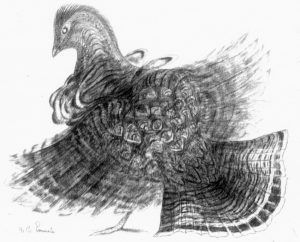“A partridge in a pear tree” is a haunting holiday refrain from the melody The Twelve Days of Christmas, first circulated in 1780 as a children’s game.
Each verse had to be recited verbatim in proper sequence until the first mistake prompted the penalty of giving a kiss or piece of candy to other players by the participant. With each successive verse, the partridge is joined by other gifts that include no less than five varieties of fowl, such as calling birds, French hens, turtle doves, geese, and swans, each exulted as a royal gift of Elizabethan courtyard pageantry.
The partridge’s real name is the ruffed grouse for the ruff of feathers around its neck, and it is renowned and revered as a woodland drummer in spring.
Like the barnyard rooster of Chaucer’s Chanticleer that crows and beats its wings at dawn, the partridge traps air against its chest with twenty or more wing beats per second in a feathery summons to attract females to join him for mating in the solar planetary apex of earthly reproduction.
In addition to Christmas and spring, the partridge becomes a representation of overdoing seasonal celebration in autumn, flying through picture windows after feasting on fermented berries to get high and mistaking a reflection of plate glass for an opening in the trees.
And later, in winter, during those ‘twelve days of Christmas’ when their normal earthly food supply is buried beneath a blanket of snow in orchards near my house, I have seen them climbing like parrots up into the bare branches of apple and pear trees to fill their beaks with buds and mast already forming for spring. Thus, the narrative of the song seemingly stems from seasonal observation of nature.
Yet, how did a ground nesting down-to-Earth bird become such a symbolic image of Christmas celebration? Perhaps Yuletide singing of this carol has become like a planetary echo in the mind, orchestrated with heavenly music of the spheres, as a bright and shining star in the sky over the little town of Bethlehem, which guided the Magi with gifts of frankincense and myrrh to celebrate the coming of the Lord.
May the contribution of my article and drawing be a gift to you as a reader wishing you a Merry Christmas and a very Happy New Year.
By George B. Emmons
